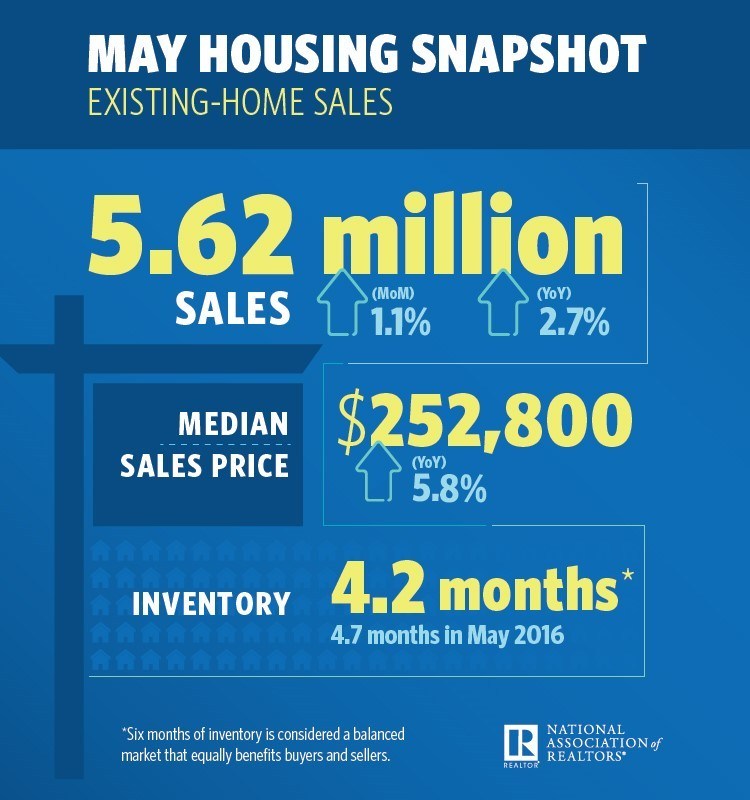Existing-home sales bloomed in May after a rainy April, with the median days on market at a new low and the median sales price at a new high, the National Association of REALTORS® (NAR) reports.
Existing-home sales totaled 5.62 million, a 1.1 percent increase from April and a 2.7 percent increase from one year prior. Inventory increased 2.1 percent to 1.96 million—though still 8.4 percent below one year prior.

“The job market in most of the country is healthy and the recent downward trend in mortgage rates continues to keep buyer interest at a robust level,” says Lawrence Yun, chief economist at NAR. “Those able to close on a home last month are probably feeling both happy and relieved. Listings in the affordable price range are scarce, homes are coming off the market at an extremely fast pace and the prevalence of multiple offers in some markets are pushing prices higher.”
Inventory is currently at a 4.2-month supply. Existing homes averaged 27 days on market in May, two fewer days than in April and five fewer days than one year prior. Non-distressed homes took 27 days to sell. All told, 55 percent of homes sold in May were on the market for less than one month.
“The bottom line is that there are fewer homes on the market, and they are selling faster,” says Joseph Kirchner, senior economist at realtor.com®. “Tightening supplies have caused steady price growth in the existing-home market; sales are up 2.7 percent since May 2016. In fact, the supply of homes on the market fell from 4.7 months’ worth last May to 4.2 months last month.
“With new and existing supply failing to catch up with demand, several markets this summer will continue to see homes going under contract at this remarkably fast pace of under a month,” Yun says.
“This is a strong market for sellers, which is good news for people who are downsizing or settling an estate,” Kirchner says. “It’s bad news for millennials, first-time buyers or second-time buyers looking to upsize for that baby on the way.”
The metropolitan areas with the fewest days on market in May, according to data from realtor.com, were Seattle-Tacoma Bellevue, Wash. (20 days); San Francisco-Oakland-Hayward, Calif. (24 days); San Jose-Sunnyvale-Santa Clara, Calif. (25 days); and Salt Lake City, Utah, and Ogden-Clearfield, Utah (both at 26 days).
The median existing-home price for all types of houses (single-family, condo, co-op and townhome), at the same time, was $252,800—a 5.8 percent increase from one year prior. The median price for a single-family existing home was $254,600, while the median price for an existing condo was $238,700.
“Home prices keep chugging along at a pace that is not sustainable in the long run,” says Yun. “Current demand levels indicate sales should be stronger, but it’s clear some would-be buyers are having to delay or postpone their home search because low supply is leading to worsening affordability conditions.”
Single-family existing-home sales came in at 4.98 million in May, a 1 percent increase from 4.93 million in April and a 2.7 percent increase from 4.85 million one year prior. Existing condo and co-op sales came in at 640,000, a 1.6 percent increase from April and a 3.2 percent increase from one year prior.
Twenty-two percent of existing-home sales in May were all-cash, with 16 percent by individual investors. Five percent were distressed.
Existing-home sales in the Northeast rose 6.8 percent to 780,000, with a median price of $281,300. Existing-home sales in the West rose, as well, 3.4 percent to 1.22 million, with a median price of $368,800. Existing-home sales in the South also rose, 2.2 percent to 2.34 million, with a median price of $221,900. Existing-home sales in the
Midwest fell 5.9 percent to 1.28 million, with a median price of $203,900.
For more information, please visit www.nar.realtor.
For the latest real estate news and trends, bookmark RISMedia.com.











